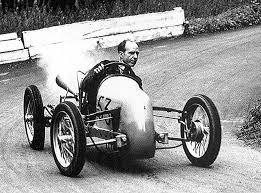History is important, as without history there could be no today. Man has always been fascinated by self-propelled vehicles, with the earliest example being the steam tractor built by Nicolas-Joseph Cugnot for the French government in 1771. Not only did it carry a payload of 4 metric tonnes, but he, and it, are also remembered as having the first road accident when the esteemed Monsieur Cugnot lost control trying to break at 4 km/h and demolished a stone wall in the grounds of the Paris Arsenal.
Like most retrospectives, there is always an air of romanticism when you look back at the start of any new form of racing. Myth becomes a mixture of fact and fiction, and it should not be forgotten that motor racing itself is only just over 100 years old. The Gordon Bennett races, which were the first truly international events, became fact through the love of speed and competition that the motor car gave to mankind.
The drivers then were as colorful as the racing cars of today. The wild man of the turn of the century motoring, Camille Jenatzy, AKA The Red Devil (1868-1913) was the first man to exceed 65 mph in his electric car called La Jamais Contente and claimed the world land speed record. He also won the Gordon Bennett Trophy in 1903 in a stripped touring Mercedes. The event was held in Ireland over 320 miles and Jenatzy won at an average speed of 49.2 miles per hour! Not bad for 1903!
However, his career (and life) ended when he was shot in the Ardennes by his mate who mistook him for a wild boar (and I am sure he would have been fairly wild about that too). What an end! Shot in the Ardennes (that’s a forest, not part of his anatomy).
The heroes of those days remain in the collective minds of enthusiasts today. Louis Renault was a very well known driver in the early 1900s, who used the sport to publicize his cars. Something that continues to this day, with Fernando Alonso winning the world championship in 2006 aboard a Renault.

Even Henry Ford I owed his success to the Ford racers that he built, which in turn gave him enough credibility to raise the finance to build his first Model Ts. The great American race car driver Barney Oldfield was given his start in motor racing by the same Henry Ford. Ford had built two 18 litre monsters in 1902 and Barney Oldfield took over one, raced and won at the Grosse Point fairground. What was so remarkable about Barney Oldfield’s first race was that he had never driven a car before, only raced bicycles! Or so the legend has it. No, the affinity between man, machinery and the need for speed is part of the human psyche. We cannot ignore it.
However, for most people, up to and immediately after WW II, motor sport was a spectator sport. Only the rich could really indulge themselves in racing. The Bentley boys who were so successful at the Le Mans 24 Hour in the 1930s were not just rich. They were mega rich.
Even Thailand’s first international motor racing hero, Prince Bira (after whom the circuit and kart track outside Pattaya was named) was an aristocrat from the royal house of Siam. He was a prince and it was his cousin Prince Chula who was rich enough to be able to purchase a brand new ERA for his 21 year old cousin that set Prince Bira on the road (and track) to fame.
However, it was not till after the hostilities that motor sport began to become more affordable, as new types of home-built inexpensive race cars began to appear on the British and European tracks, most of which were disused airstrips left over from the war. The small 500 cc rear-engined lightweight cars began to have a strong following, but it was not the 500 cc Coopers that were driven by such notables as Sir Stirling Moss that were the trail-blazers. That honor belongs to a Colin Strang who in August 1946 won the Prescott Hill Climb in his home built Vincent-HRD Strang Special.
Affordable motor sport was just beginning, as the not-so-financial drivers wanted to have something to fill that need for speed. However, the next step probably owed as much to kids in their billy-carts as it did to pure motor sport.
For longer than there had been motor cars, there had been billy carts, some even drawn by billy goats (hence the name). In the UK and the USA these were also called soap-box carts. However, the need for speed begins in childhood, and unofficial races down hills were soon the norm in all communities.
Today, that need for speed is still there, and so are the gravity powered billy carts. In the UK, soap box derbies are still popular, such as the Red Bull race, held at the Goodwood Festival of Speed (is there anything that Red Bull doesn’t sponsor).
This extends even to the Hill Tribes in Northern Thailand. During the Hmong New Year celebrations, “race” carts fashioned from the wooden carts used for hauling produce are entered, where Hmong boys and men will race against members of the Lisu, Engor, and Muser hilltribes. These races are sponsored by the Royal Project Foundation, the Tourism Authority of Thailand (TAT), and also the Red Bull brand energy drink. (There really isn’t anywhere without Red Bull, is there?)
But what about children who lived in areas without hills? Enterprising fathers began by putting car starter motors on the wooden carts, along with a car battery. The electric powered cart was born, which amongst other things, gave birth to the go-kart (and the golf cart).
And of course, go-karts are where we once found Michael Schumacher, Lewis Hamilton and most of the other F1 drivers of today, some of which are sponsored by Red Bull, so we’re back to where we started.




